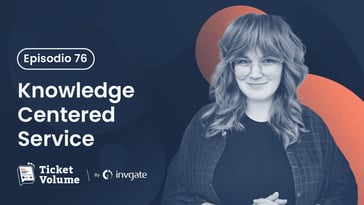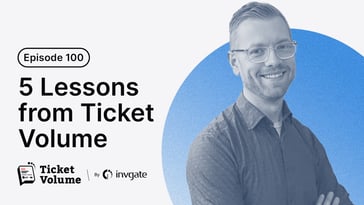Are you ready to tackle the hidden IT Asset Management (ITAM) challenges that could impact your organization's efficiency and success? In this dynamic field, continuous learning is not just an option; it's a necessity.
To equip you with insights, we delved into “ITAM Challenges: Epic Fails, Red Flags, And Tales From the Battlefield” during September's Ticket Volume podcast live recording.
David Foxen – ITAM Professional and Founder of SAM Beast Consulting Ltd –, as a guest, joined Matt Beran – Ticket Volume host and InvGate Product Specialist – for a candid conversation about the most common ITAM challenges and provided actionable solutions.
Keep scrolling to explore a concise written summary of this episode – but remember that you can take your engagement a step further. Register for our monthly live recordings, where you can participate in real-time discussions.

From terrible to perfect Asset Management
In the evolution of IT Asset Management, there is a remarkable journey from its primitive beginnings to the ongoing pursuit of perfection.
As Matt baptized the “caveman” era of ITAM, organizations found themselves in a state of disarray, characterized by a lack of processes and control, limited awareness of software and hardware inventory, inefficient Risk Management, inadequate license tracking, and poor customer service for end-users. This phase was defined by chaos as organizations grappled with the challenge of Asset Management, resulting in inefficiencies and potential risks.
As progress unfolds along the ITAM timeline, the pursuit of perfection remains a perpetual endeavor, even in 2023. Some of the elements defining perfection in ITAM today encompass:
- Automation of processes
- In-depth data analysis
- Optimization and cost savings
- Integration of artificial intelligence, machine learning, and Contract Management.
However, the dynamic nature of technology ensures that what is deemed perfect today may evolve further in the coming years. The sky's the limit for ITAM's potential as it continues to adapt and transform in response to technological advancements and organizational needs.
|
|
"I really don't think we've understood exactly what perfect could be for ITAM. ITAM is still a relatively new function within organizations. [...] You can really hit a really mature ITAM function with lots of automation, lots of data analysis, lots of optimization, savings, etc., but that's perfect in 2023. Who knows what’s perfect in 2033?" David Foxen |
Addressing IT Asset Management challenges
Despite the progress made in IT Asset Management, persistent challenges continue to affect organizations. One significant hurdle is the reluctance of certain organizations to invest in ITAM. Common reasons for this reluctance include:
- Lack of understanding: Some organizations fail to grasp the profound importance of IT Asset Management. They view it as an ancillary concern rather than a strategic imperative.
- Sufficiency of existing practices: There is a prevailing belief in certain quarters that current ITAM practices are sufficient to meet organizational needs. This mindset can be a significant impediment to progress.
- Misconceptions about the cloud: The cloud's transformative potential is undeniable, but misconceptions about its impact on ITAM persist. Some organizations erroneously believe that the cloud renders ITAM obsolete when, in fact, it underscores the need for robust management of digital assets.
To overcome these challenges and optimize IT Asset Management, David proposed different strategies that organizations should consider.
1. Prioritize hardware refresh planning
The cornerstone of ITAM excellence often lies in proactive hardware refresh planning. Organizations should craft comprehensive plans that detail when and how outdated equipment should be replaced. An up-to-date database should complement this, housing critical information such as warranty end dates and internal lifecycle data, which greatly facilitates budgeting. To ensure long-term sustainability, it's essential to extend refresh planning beyond the immediate horizon.
2. Enhance IT Asset Disposition (ITAD)
IT Asset Disposition is an often-overlooked facet of ITAM that can yield substantial value. Organizations are encouraged to implement a comprehensive ITAD process that maximizes the value of retiring assets. This includes exploring avenues like reselling or recycling old equipment and components, thereby generating revenue while adhering to responsible environmental practices. Regularly reviewing and updating ITAD procedures is essential to remain agile in the face of evolving technology and market trends.
3. Streamline procurement and deployment
Optimizing hardware procurement and deployment processes is paramount in an era where technology expectations run high. By enhancing coordination between IT and procurement teams, organizations can significantly reduce lead times. Creating a streamlined, efficient, and transparent process for requesting, procuring, and deploying hardware ensures that the tech-savvy workforce's needs are met promptly and seamlessly.
Building strong collaborations
The conversation touched on the importance of alignment with finance and HR teams in IT Asset Management. David emphasized that finance is a critical ally and that building strong relationships with these departments can yield invaluable insights.
Finance plays a crucial role in budgeting, depreciation, and financial management related to assets. Understanding the financial aspect of Asset Management allows professionals to optimize budgets and resources efficiently.
HR and recruitment teams also play a pivotal role in ITAM by providing insights into headcount changes, project projections, and workforce planning.
Collaborating closely with these teams enables ITAM to accurately anticipate hardware and software needs.
What to look for in software and hardware vendors
When forming relationships with software and hardware vendors in ITAM, there's a common misconception that the lowest cost should be the sole deciding factor. However, as David highlights, this oversimplification can lead to suboptimal choices. So, what should you consider when searching for the right vendor? David highlighted three fundamental aspects.
1. Excellent communication
The cornerstone of any successful vendor relationship is excellent communication. David emphasized the importance of vendors maintaining open and clear lines of communication with their clients. This means not leaving clients in the dark but being proactive in keeping them informed.
Imagine you don't want to be constantly checking in, wondering when your equipment will be delivered or if there are any significant supply chain disruptions. Instead, a reputable vendor should take the initiative to provide updates on delivery schedules and any relevant market changes.
This open dialogue ensures ITAM professionals can plan effectively, make informed decisions, and avoid surprises. Whether it's hardware vendors sharing information about delivery delays or software vendors alerting organizations to licensing changes, transparency, and proactivity should be non-negotiable traits.
2. Proactiveness
Proactiveness from vendors is a key trait to seek. The best vendors are not merely reactive but actively strive to anticipate their clients' needs and concerns. They go beyond fulfilling immediate requirements; they help organizations prepare for the future.
For instance, software Value Added Resellers (VARs) who are worth their weight in gold are those who approach clients with a heads-up. They inform organizations about forthcoming changes in contract terms, alterations to licensing models, or shifts in agreement structures. Such proactive communication allows ITAM professionals to brace for impacts, adjust their strategies, and avoid last-minute scrambles.
3. Globalized nature of the vendor
In today's interconnected world, the globalized nature of a vendor is a crucial consideration. Organizations often span multiple regions and time zones, and their ITAM needs are no different. When choosing a vendor, ensure they can match your global footprint.
This means vendors should provide 24/7 coverage and support to accommodate clients in various time zones. Waiting for a vendor's response due to time zone differences can be frustrating and counterproductive. A dependable vendor will seamlessly cater to all regions, ensuring that no part of your organization is left waiting for assistance.
|
|
"There's nothing worse than having a hardware or software VAR with a global ITAM team that are only online during US hours or only online during European hours or UK hours. [...] If you're a global organization, that is a huge thing for me to make sure that they've got 24/7 coverage, that they can cover all of our regions as well, that they can ship to all of our regions." David Foxen |
Additionally, the vendor should possess the expertise to navigate logistical challenges related to global operations. They should have the means to ship products to different regions and may even assist with third-party transportation companies for import and export.
Furthermore, vendors should provide insights into the commercial viability of procuring software locally versus through a global agreement. Currency fluctuations and regional pricing variations can significantly impact costs. A vendor that looks out for your best interests will provide honest recommendations, even if it means suggesting a local purchase for cost-effectiveness.
CMDB vs. ITAM: Where to begin?
The podcast also addressed the common dilemma of whether to invest in Configuration Management (CMDB) or IT Asset Management first. David's response highlighted the importance of context and organizational goals.
From an ITAM perspective, David advocated prioritizing the Asset Management Database (AMDB). He emphasized the need to establish robust ITAM processes, populate the AMDB with accurate data, and align it with Asset Management goals. Having an accurate inventory of assets, software, and infrastructure forms the foundation of effective ITAM.
While acknowledging the value of CMDB, David recommended tackling it after ITAM is matured. Once ITAM processes are in place and the AMDB is reliable, organizations can consider integrating Configuration Items (CIs) into the CMDB to enhance their understanding of asset performance and interconnections.
David's pragmatic approach suggests that while CMDB and ITAM are interrelated, the priority should be based on the organization's specific objectives and readiness. He pointed out that ITAM can yield financial benefits that can, in turn, fund configuration management initiatives.
To sum up
In this glimpse into David Foxen's insights on IT Asset Management, we've explored valuable strategies and perspectives that can steer your organization toward greater efficiency and success. However, this is just the tip of the iceberg. Listen to the entire conversation for further insights and knowledge!
You can find the complete episode on Apple Podcasts, Spotify, YouTube, or your favorite podcast platform. And don't forget to subscribe if you wish to participate in our monthly live sessions!















